A Photonic 1 × 4 Power Splitter Based on Multimode Interference in Silicon–Gallium-Nitride Slot Waveguide Structures
Abstract
:1. Introduction
2. The 1 × 4 Power Splitter Structure and the Theoretical Aspect
3. Simulation Results
4. Preliminary Fabrication Results
5. Conclusions
Author Contributions
Conflicts of Interest
References
- Huang, Z.; Scarmozzino, R.; Osgood, R.M., Jr. A new design approach to large input/output number multimode interference couplers and its application to low-crosstalk WDM routers IEEE Photon. Technol. Lett. 1998, 10, 1292–1294. [Google Scholar] [CrossRef]
- Phillips, A.J.; Senior, J.M.; Mercinelli, R.; Valvo, M.; Vetter, P.J.; Martin, C.M.; van Deventer, M.O.; Vaes, P.; Qiu, X.Z. Redundancy Strategies for a High Splitting Optically Amplified Passive Optical Network. J. Lightwave Technol. 2011, 19, 137–149. [Google Scholar] [CrossRef] [Green Version]
- Soldano, L.B.; Pennings, E.C.M. Optical multimode interference devices based on self-imaging: Principles and applications. J. Lightwave Technol. 1995, 13, 615–627. [Google Scholar] [CrossRef]
- Besse, P.A.; Bachmann, M.; Melchior, H.; Soldano, L.B.; Smit, M.K. Optical bandwidth and fabrication tolerances of multimode interference couplers. J. Lightwave Technol. 1994, 12, 1001–1009. [Google Scholar] [CrossRef]
- Fujisawa, T.; Koshiba, M. Theoretical Investigion of ultrasmall polarization-insensitive multimode interference waveguide based on sandwiched structures. IEEE Photonics Technol. Lett. 2006, 18, 1246–1248. [Google Scholar] [CrossRef]
- Xu, C.; Hong, X.; Huang, W.P. Design optimization of integrated BiDi triplexer optical filter based on planar lightwave circuit. Opt. Express 2006, 14, 4675–4686. [Google Scholar] [CrossRef] [PubMed]
- Irace, A.; Breglio, G. All-silicon optical temperature sensor based on Multi-Mode Interference. Opt. Express 2003, 11, 2807–2812. [Google Scholar] [CrossRef] [PubMed]
- Zhang, Y.; Liu, L.; Wu, X.; Xu, L. Splitting-on-demand optical power splitters using multimode interference (MMI) waveguide with programmed modulations. Opt. Commun. 2008, 281, 426–432. [Google Scholar] [CrossRef]
- Hosseini, A.; Kwong, D.N.; Zhang, Y.; Subbaraman, H.; Xu, X.; Chen, R.T. 1× N Multimode Interference Beam Splitter Design Techniques for on-Chip Optical Interconnections. J. Lightwave Technol. 2011, 17, 510–514. [Google Scholar] [CrossRef]
- Tajaldini, M.; Jafri, M.Z.M. Ultracompact Multimode Interference Coupler Designed by Parallel Particle Swarm Optimization with Parallel Finite-Difference Time-Domain. J. Lightwave Technol. 2014, 32, 1282–1289. [Google Scholar] [CrossRef]
- Almeida, V.R.; Xu, Q.; Barrios, C.A.; Lipson, M. Guiding and confining light in void nanostructure. Opt. Lett. 2004, 29, 1209–1211. [Google Scholar] [CrossRef] [PubMed]
- Baehr-Jones, T.; Hochberg, M.; Wang, G.; Lawson, R.; Liao, Y.; Sullivan, P.A.; Dalton, L.; Jen, A.K.Y.; Scherer, A. Optical modulation and detection in slotted silicon waveguides. Opt. Express 2005, 13, 5216–5226. [Google Scholar] [CrossRef] [PubMed]
- Xu, Q.; Almeida, V.R.; Panepucci, R.R.; Lipson, M. Experimental demonstration of guiding and confining in nanometer-size low-refractive index material. Opt. Lett. 2004, 29, 1626–1628. [Google Scholar] [CrossRef] [PubMed]
- Xiao, J.; Liu, X.; Sun, X. Design of an ultracompact MMI wavelength demultiplexer in slot waveguide structures. Opt. Express 2007, 15, 8300–8308. [Google Scholar] [CrossRef] [PubMed]
- Malka, D.; Sintov, Y.; Zalevsky, Z. Design of a 1 × 4 silicon-alumina wavelength demultiplexer based on multimode interference in slot waveguide structures. J. Opt. 2015, 17, 1–9. [Google Scholar] [CrossRef]
- Barrios, C.A.; Lipson, M. Electrically driven silicon resonant light emitting device based on slotwaveguide. Opt. Express 2005, 13, 10092–10101. [Google Scholar] [CrossRef] [PubMed]
- Fujisawa, T.; Koshiba, M. Polarization-independent optical directional coupler based on slot waveguides. Opt. Lett. 2006, 31, 56–58. [Google Scholar] [CrossRef] [PubMed]
- Qiu, F.; Spring, A.M.; Maeda, D.; Ozawa, M.-A.; Odoi, K.; Otomo, A.; Aoki, I.; Yokoyama, S. A hybrid electro-optic polymer and TiO2 double-slot waveguide modulator. Nat. Sci. Rep. 2015, 5, 8561. [Google Scholar] [CrossRef] [PubMed]
- Zhu, S.; Liow, T.Y.; Lo, G.Q.; Kwong, D.L. Silicon-based horizontal nanoplasmonic slot waveguide for on-chip integration. Opt. Express 2011, 19, 8888–8902. [Google Scholar] [CrossRef] [PubMed]
- Brubaker, M.D.; Blanchard, P.T.; Schlager, J.B.; Sanders, A.W.; Roshko, A.; Dufft, S.M.; Gray, J.M.; Bright, V.M.; Sanford, N.A.K.; Berthness, K.A. On-Chip Optical Interconnects Made with Gallium Nitride Nanowiers. Nano Lett. 2013, 13, 374–377. [Google Scholar] [CrossRef] [PubMed]
- Carnevale, S.D.; Kent, T.F.; Phillips, P.J.; Mills, M.J.; Rajan, S.; Myers, R.C. Polarization-induced pn diodes in wide-band-gap nanowires with ultraviolet electroluminescence. Nano Lett. 2012, 12, 915–920. [Google Scholar] [CrossRef] [PubMed]
- Purnamaningsih, R.W.; Saraswati, I.; Poespawati, N.R.; Dogheche, E. Design of GaN-Based Low-Loss Y-Branch Power Splitter. Makara J. Technol. 2014, 18, 101–104. [Google Scholar] [CrossRef]
- Purnamaningsih, R.W.; Poespawati, N.R.; Dogeche, E.; Pavlidis, D. A Simple Three Branch Optical Power Splitter Design Based on III-Nitride Semiconductor for Optical Telecommunication. Int. J. Technol. 2016, 7, 710–718. [Google Scholar] [CrossRef]
- Hui, R.; Taherion, S.; Wan, Y.; Li, J.; Jin, S.X.; Lin, J.Y.; Jiang, H.X. GaN-basesd waveguide devices for long-wavelength optical communications. Appl. Phys. Lett. 2003, 82, 1326–1328. [Google Scholar] [CrossRef]
- Zhang, Y.; McKnight, L.; Engin, E.; Watson, I.M.; Cryan, M.J.; Gu, E.; Thompson, M.G.; Calvez, S.; O’Brien, J.L.; Dawson, M.D. GaN directional couplers for integrated quantum photonics. Appl. Phys. Lett. 2011, 99, 161119. [Google Scholar] [CrossRef]
- Xiao, X.; Li, X.; Fen, X.; Cui, K.; Liu, F.; Huang, Y. Designing gallium nitride slot waveguide operating within visible band. Opt. Quant Electron. 2015, 47, 3705–3713. [Google Scholar] [CrossRef]
- Katigbak, A.; Strother, J.F.; Lin, J. Compact silicon slot waveguide polarization splitter. Opt. Eng. 2009, 48, 080503. [Google Scholar] [CrossRef]
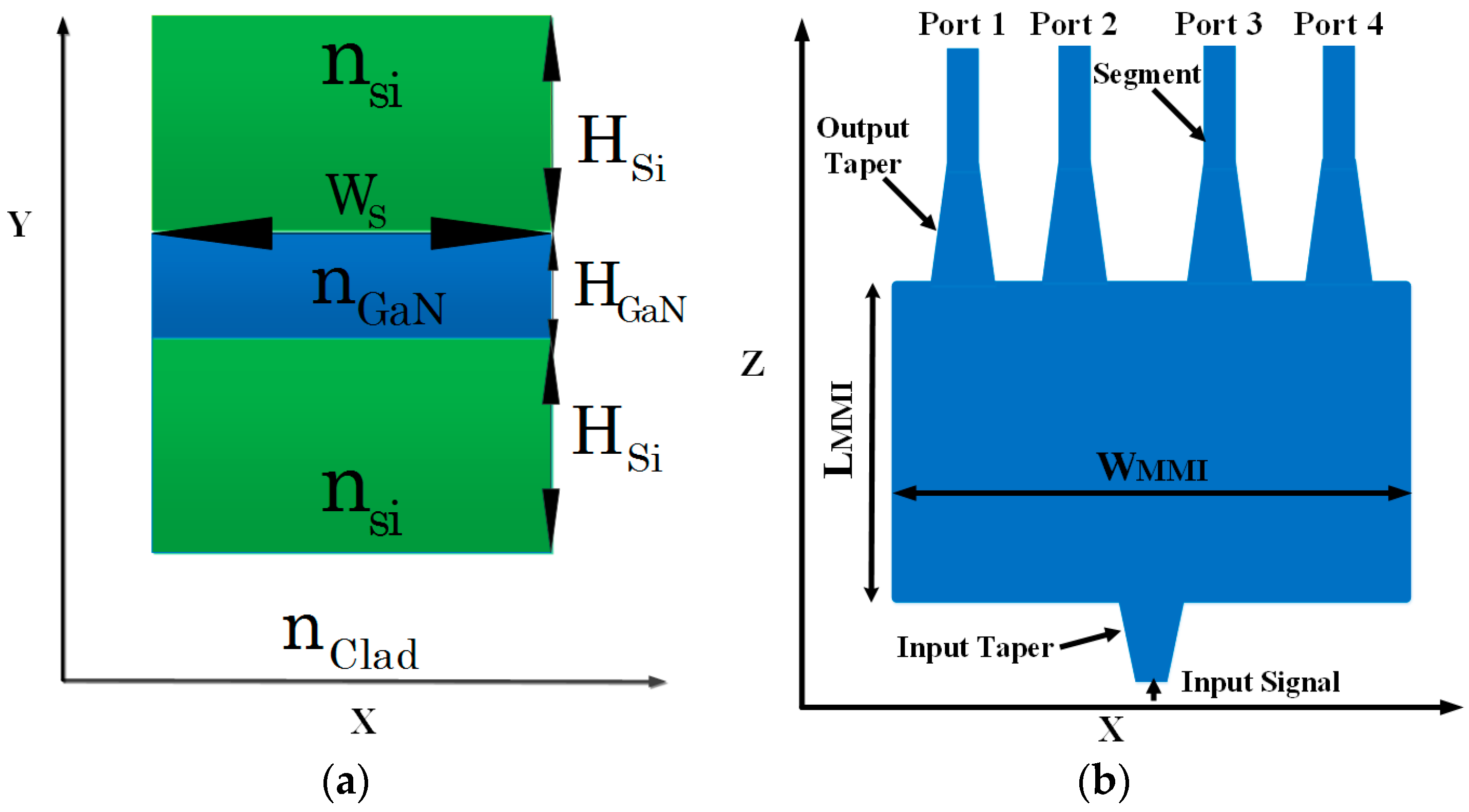

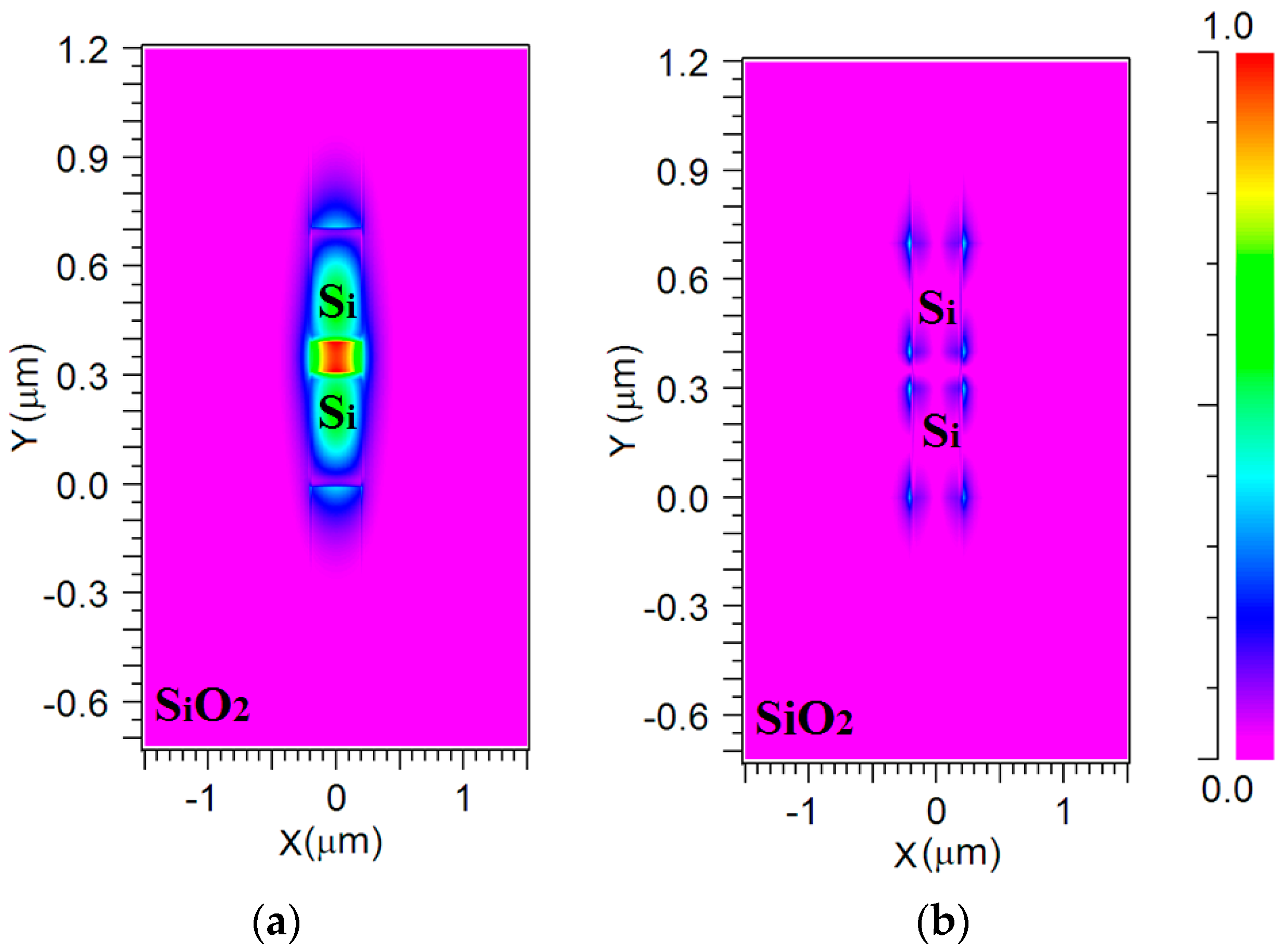

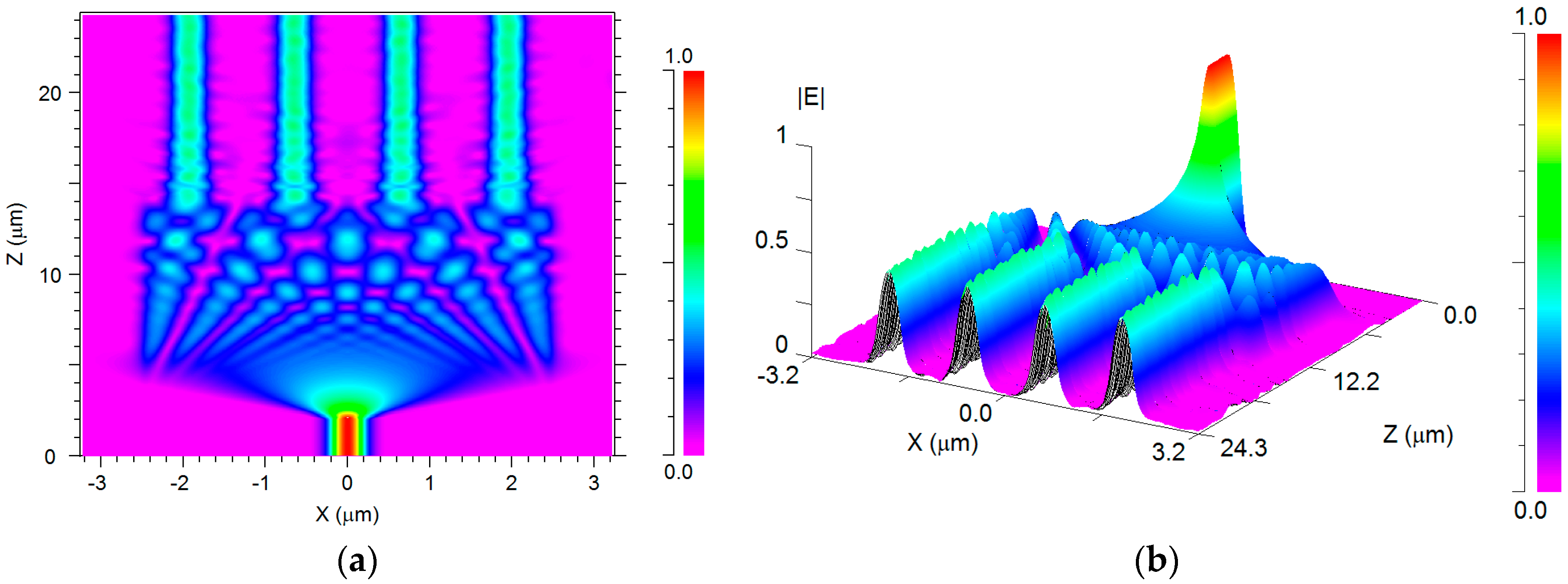
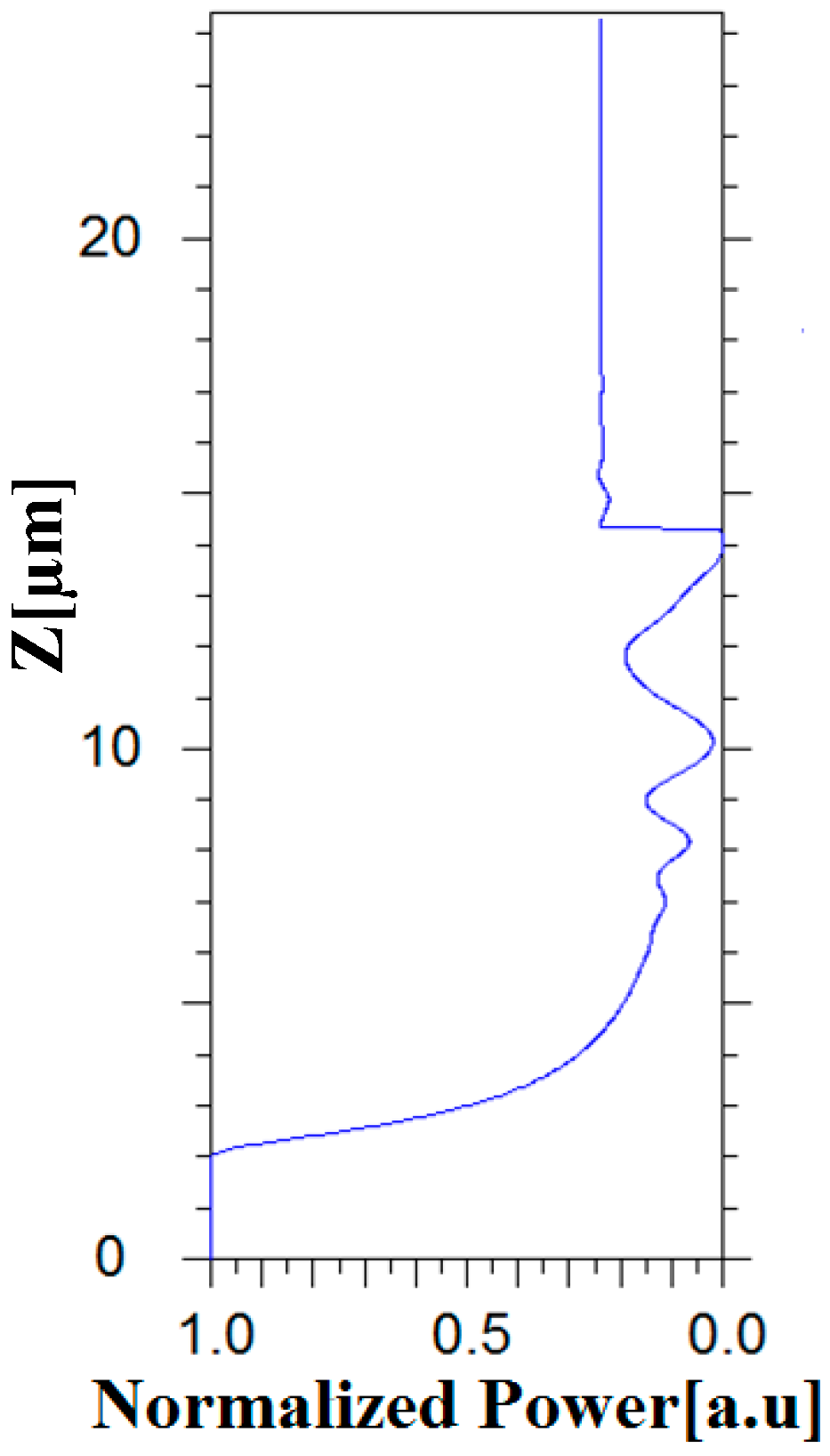
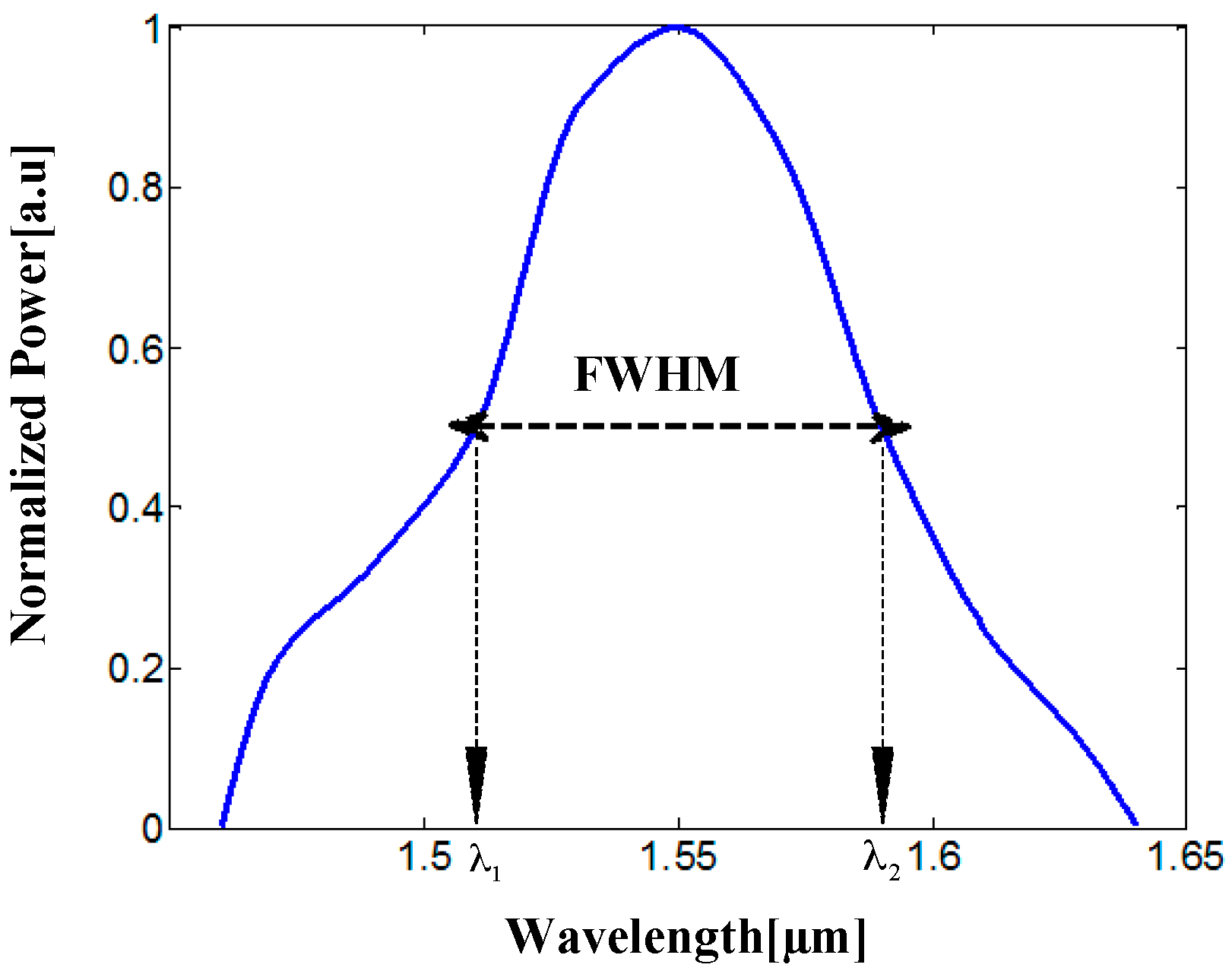
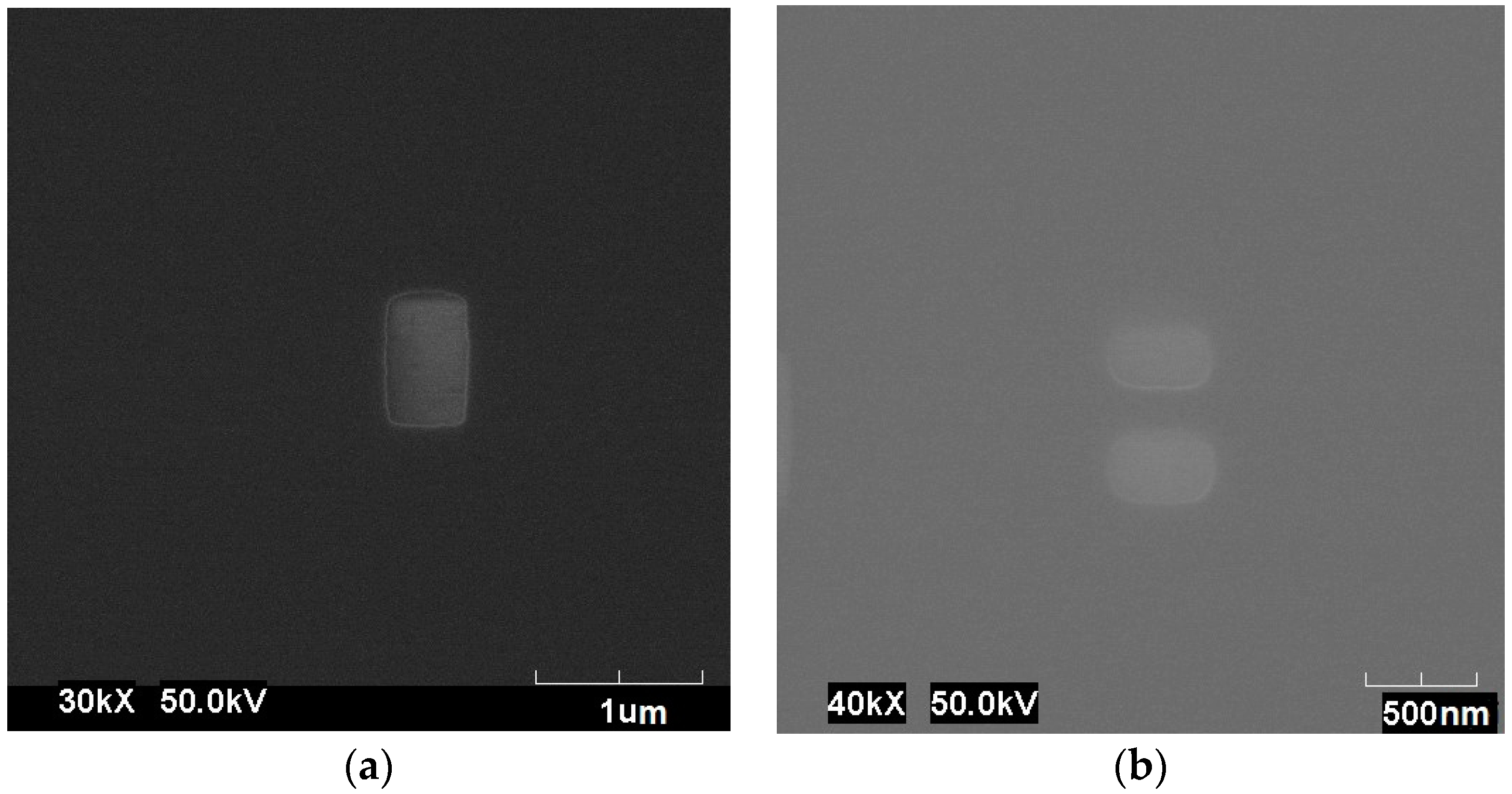
© 2016 by the authors; licensee MDPI, Basel, Switzerland. This article is an open access article distributed under the terms and conditions of the Creative Commons Attribution (CC-BY) license (http://creativecommons.org/licenses/by/4.0/).
Share and Cite
Malka, D.; Danan, Y.; Ramon, Y.; Zalevsky, Z. A Photonic 1 × 4 Power Splitter Based on Multimode Interference in Silicon–Gallium-Nitride Slot Waveguide Structures. Materials 2016, 9, 516. https://doi.org/10.3390/ma9070516
Malka D, Danan Y, Ramon Y, Zalevsky Z. A Photonic 1 × 4 Power Splitter Based on Multimode Interference in Silicon–Gallium-Nitride Slot Waveguide Structures. Materials. 2016; 9(7):516. https://doi.org/10.3390/ma9070516
Chicago/Turabian StyleMalka, Dror, Yossef Danan, Yehonatan Ramon, and Zeev Zalevsky. 2016. "A Photonic 1 × 4 Power Splitter Based on Multimode Interference in Silicon–Gallium-Nitride Slot Waveguide Structures" Materials 9, no. 7: 516. https://doi.org/10.3390/ma9070516




